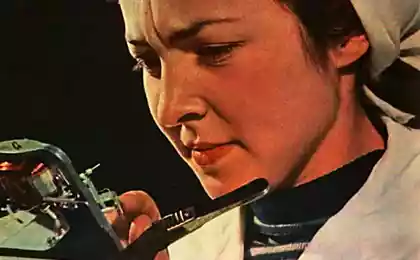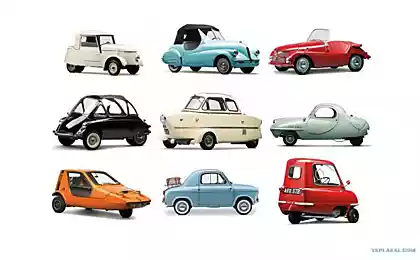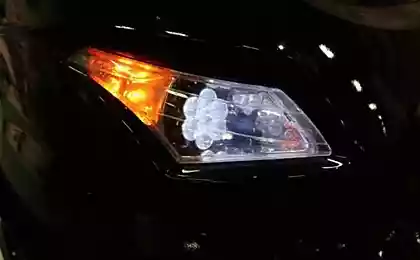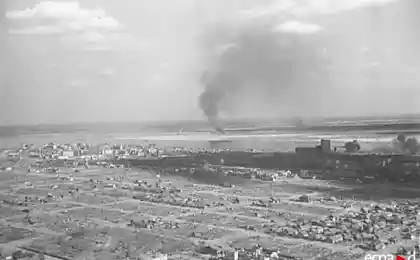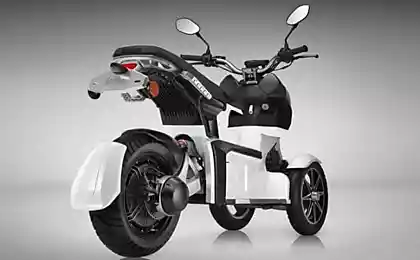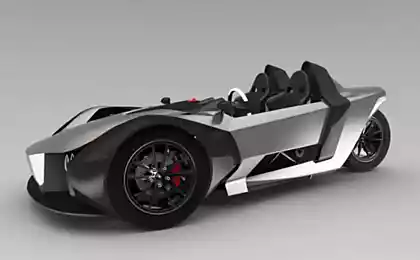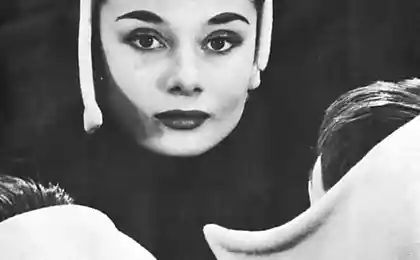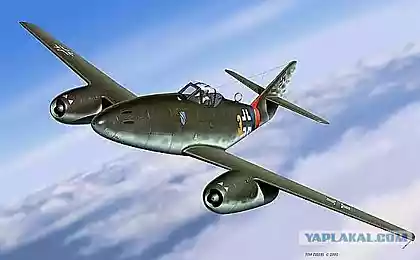533
Three-Wheeled Messerschmitt, 1954
Kabinenroller Messerschmitt — Messerschmitt Kabinenroller
This machine with legendary aircraft the name "Messerschmitt" (Messerschmitt) was one of the most original and distinctive means of transportation, born in postwar Germany in the not too wealthy buyer, who wished to have their own means of transportation.
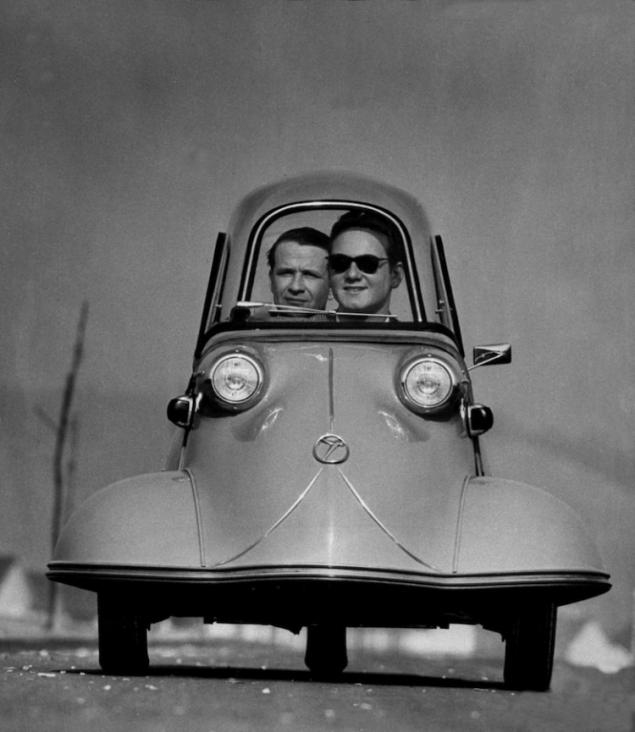
It was a cross between a car, a motorcycle and a scooter that looks like a fuselage of a light aircraft without wings with leans to the side of the transparent canopy. In the post-war terminology, it belongs to a special class of extremely simple and cheap microcar, called in German "kabinenroller", that is, the booths on wheels of the scooter. In its short life, these cars wore three different names, of which history has left only one "Messerschmitt", although the famous German aircraft designer Willy Messerschmitt nothing to do with him had no.
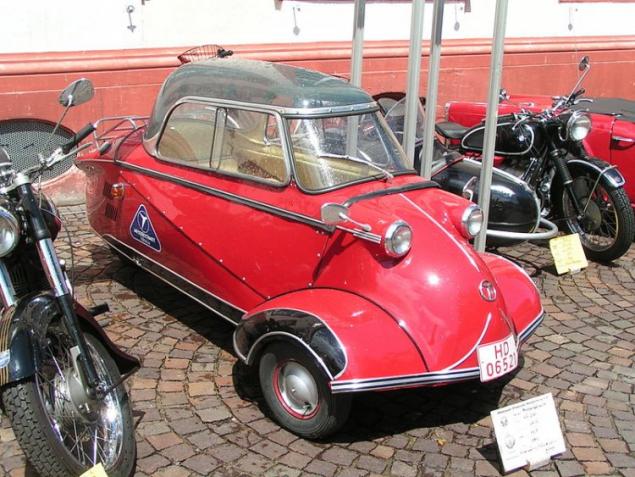
It all started in 1946, when the engineer Fritz Fandom (Fritz Fend) of Rosenheim began to build a simple wheelchair for disabled veterans. At first it was pedal cars hand-or pedal-operated, but since 1948, the Fandom has equipped their single cylinder motorcycle motors with power up to 3 HP that caused the single rear wheel. So the simplest stroller turned into a three-wheeled micro-car, only with a single utilitarian open body on the Bicycle wheels, weighing only 175 kg. the Value of 800-1300 DM, it is allowed to buy them even the most poor German. It strongly pushed the case Find, and in 1950 he was offered a more solid car on three wheels motorolleri with elongated wedge-shaped body with hinged top and one headlight. The driver and passenger were placed in it in tandem — one after the other, like in the cockpit of a light aircraft. Despite the rise in prices to 2000 marks a success, allowing Fengdu to produce a very large batch of 250 machines. In 1952 he built a new more attractive microcar with original streamlined steel body on a tubular frame and a hinged Plexiglas top. For rear wheel drive served 150 CC motor "Fichtel und Sachs" (Fichtel & Sachs) with a power of 9 HP, the Car weighed only 150 kg, and its maximum speed was stunning for such a simple means of transport value — 80 km/h.
Meanwhile, the aviation company "Messerschmitt", which after the war was forbidden to produce aircraft, breathing hard. After surviving the bombing of the plant of its plants were idle, and to maintain life in them the leaders of the company were ready to release anything you want. History is silent that brought so many different scope brands as "Fandom" and "Messerschmitt". Most likely a coincidence, but it is possible — aviation style creations Find. Anyway, in the beginning of 1953, all of his production was transferred to Regensburg machine-building plant in Bavaria, belonging to the former Empire of the Messerschmitt. So, quite unexpectedly, at the spring Geneva motor show the same year appeared a very unusual three-wheeled car "Messerschmitt". Even the experts, don't pay any attention to the fun Find, were plunged into the shock of seeing so elegant and petite whether automobile or a motorcycle. It was supplied by the aviation body with a predatory "beak", similar to the wings of the aircraft fairing of the front wheels and the previously unseen in the automotive industry transparent cap that the airplane leaned to the side, opening access to the cramped interior, where two seats faced each other. And it is quite an unusual prestigious brand "Messerschmitt", which was associated only with the fighters of world war II. The car has received index KR-175, where the letters were an abbreviation of the term "Kabinenroller" (Kabinenroller), and the numbers indicated displacement 9 HP motor. In 1955 in Regensburg began mass production of the second variant of the KR-200 with motor 9.7 forces. Design of both machines were the same. They were equipped with a single cylinder two-stroke motorcycle engines "Fichtel und Sachs" air-cooled fuel was gasoline mixed with oil. The drivetrain consisted of a multi-plate clutch in oil bath, conventional gearbox and chain drive to single rear wheel. For reversing needed to turn off the engine and run it so that the crankshaft rotates in the opposite direction. Independent suspension of the two front wheels and one rear consisted of levers with springs, rubber elements and hydraulic shock absorbers. Control was carried out using the handles of a motorcycle type. All 8-inch wheels were equipped with drum brakes. The car had a mass of 220-240 kg, speeds up to 100 km/h and spend only 2.5-3.5 liters of fuel per 100 km. For the proof of their unlimited capabilities were organized record races, where specially prepared version has reached an incredible speed of 140 km/h In the mid-1950s, both cars were released at 50 units per day. For the first two years made 12 thousand copies, of which 30% were exported.
The name "Messerschmitt" has existed in the automotive field for very long. In 1956, the German government initiated a stocktaking of production capacity of their country. The company "Messerschmitt" again received orders for military aircraft, and automotive Department placed under the authority of the government of Bavaria. It was renamed the Regensburg engineering and coach building factory, a German name which he gave the acronym L Mr (FMR), which became the new brand continues to sidecars, although unofficially, they continued to be called "Messerschmitt". This name was not present nor on the lining of the car or in the technical documentation, although on some machines it was common to see a small emblem of the "Messerschmitt" with a stylized eagle. The first new company of FMR was the Roadster 0-201, but its main achievement was the only four-wheel "Messerschmitt", but rather model FMR "Tiger-500". Very original, and this name was unofficial: for unknown reasons, it had to be cut short to index Tg-500. This version is altered from the usual three-wheeled car, spreading out the rear wheel and installing them on the swinging axis under a small fairing. "Tiger" equipped with a 2-cylinder 500-CC engine capacity of 20-25 HP Its wheelbase was shortened to 1890 mm, but the weight increased to 300 lbs. the Car has a top speed of 130 km/h and from standstill to 100 km/h were dispersed in 25, and its price in the 3400 marks were only slightly lower than the mass of the automobile of "Volkswagen". Maybe this explains that "Tiger" has not enjoyed such high demand as its predecessors. According to various sources, until 1964 they were collected from 300 to 1,000 copies. In total we made more than 65 thousand cars, bearing the brand consistently "Fandom", "Messerschmitt" and FMR.
Characteristic of the vehicle "Messerschmitt 0-200" (1955)
The number of seats — 2, Engine single cylinder two-stroke air-cooled displacement — 191 cm3, power of 9.7 HP at 5000 rpm gear Box mechanical, 4-speed. Base — 2030 mm front Track — 1080 mm. in Length 2820 mm, width 1220 mm, height — 1200 mm Weight — 240 kg. Maximum speed — 100 km/h Average fuel consumption — 3,0-3,5 l on 100 km.
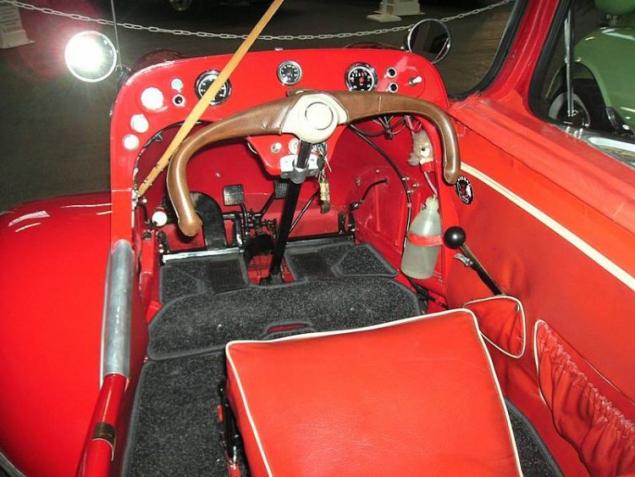



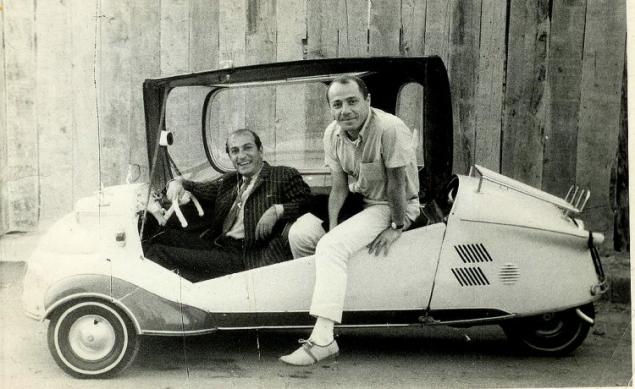
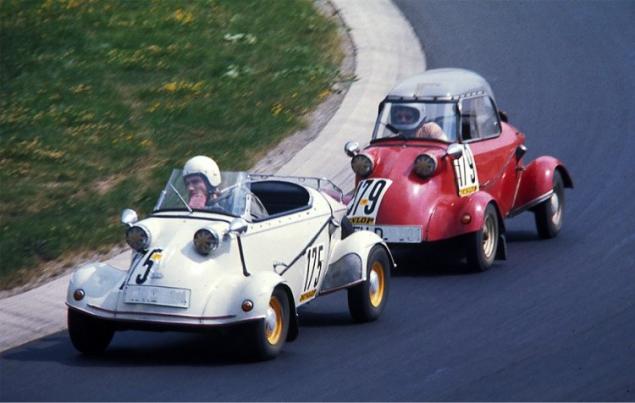
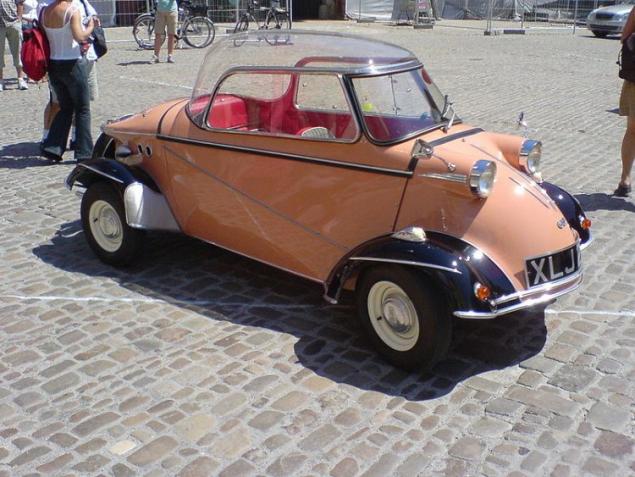


This machine with legendary aircraft the name "Messerschmitt" (Messerschmitt) was one of the most original and distinctive means of transportation, born in postwar Germany in the not too wealthy buyer, who wished to have their own means of transportation.

It was a cross between a car, a motorcycle and a scooter that looks like a fuselage of a light aircraft without wings with leans to the side of the transparent canopy. In the post-war terminology, it belongs to a special class of extremely simple and cheap microcar, called in German "kabinenroller", that is, the booths on wheels of the scooter. In its short life, these cars wore three different names, of which history has left only one "Messerschmitt", although the famous German aircraft designer Willy Messerschmitt nothing to do with him had no.

It all started in 1946, when the engineer Fritz Fandom (Fritz Fend) of Rosenheim began to build a simple wheelchair for disabled veterans. At first it was pedal cars hand-or pedal-operated, but since 1948, the Fandom has equipped their single cylinder motorcycle motors with power up to 3 HP that caused the single rear wheel. So the simplest stroller turned into a three-wheeled micro-car, only with a single utilitarian open body on the Bicycle wheels, weighing only 175 kg. the Value of 800-1300 DM, it is allowed to buy them even the most poor German. It strongly pushed the case Find, and in 1950 he was offered a more solid car on three wheels motorolleri with elongated wedge-shaped body with hinged top and one headlight. The driver and passenger were placed in it in tandem — one after the other, like in the cockpit of a light aircraft. Despite the rise in prices to 2000 marks a success, allowing Fengdu to produce a very large batch of 250 machines. In 1952 he built a new more attractive microcar with original streamlined steel body on a tubular frame and a hinged Plexiglas top. For rear wheel drive served 150 CC motor "Fichtel und Sachs" (Fichtel & Sachs) with a power of 9 HP, the Car weighed only 150 kg, and its maximum speed was stunning for such a simple means of transport value — 80 km/h.
Meanwhile, the aviation company "Messerschmitt", which after the war was forbidden to produce aircraft, breathing hard. After surviving the bombing of the plant of its plants were idle, and to maintain life in them the leaders of the company were ready to release anything you want. History is silent that brought so many different scope brands as "Fandom" and "Messerschmitt". Most likely a coincidence, but it is possible — aviation style creations Find. Anyway, in the beginning of 1953, all of his production was transferred to Regensburg machine-building plant in Bavaria, belonging to the former Empire of the Messerschmitt. So, quite unexpectedly, at the spring Geneva motor show the same year appeared a very unusual three-wheeled car "Messerschmitt". Even the experts, don't pay any attention to the fun Find, were plunged into the shock of seeing so elegant and petite whether automobile or a motorcycle. It was supplied by the aviation body with a predatory "beak", similar to the wings of the aircraft fairing of the front wheels and the previously unseen in the automotive industry transparent cap that the airplane leaned to the side, opening access to the cramped interior, where two seats faced each other. And it is quite an unusual prestigious brand "Messerschmitt", which was associated only with the fighters of world war II. The car has received index KR-175, where the letters were an abbreviation of the term "Kabinenroller" (Kabinenroller), and the numbers indicated displacement 9 HP motor. In 1955 in Regensburg began mass production of the second variant of the KR-200 with motor 9.7 forces. Design of both machines were the same. They were equipped with a single cylinder two-stroke motorcycle engines "Fichtel und Sachs" air-cooled fuel was gasoline mixed with oil. The drivetrain consisted of a multi-plate clutch in oil bath, conventional gearbox and chain drive to single rear wheel. For reversing needed to turn off the engine and run it so that the crankshaft rotates in the opposite direction. Independent suspension of the two front wheels and one rear consisted of levers with springs, rubber elements and hydraulic shock absorbers. Control was carried out using the handles of a motorcycle type. All 8-inch wheels were equipped with drum brakes. The car had a mass of 220-240 kg, speeds up to 100 km/h and spend only 2.5-3.5 liters of fuel per 100 km. For the proof of their unlimited capabilities were organized record races, where specially prepared version has reached an incredible speed of 140 km/h In the mid-1950s, both cars were released at 50 units per day. For the first two years made 12 thousand copies, of which 30% were exported.
The name "Messerschmitt" has existed in the automotive field for very long. In 1956, the German government initiated a stocktaking of production capacity of their country. The company "Messerschmitt" again received orders for military aircraft, and automotive Department placed under the authority of the government of Bavaria. It was renamed the Regensburg engineering and coach building factory, a German name which he gave the acronym L Mr (FMR), which became the new brand continues to sidecars, although unofficially, they continued to be called "Messerschmitt". This name was not present nor on the lining of the car or in the technical documentation, although on some machines it was common to see a small emblem of the "Messerschmitt" with a stylized eagle. The first new company of FMR was the Roadster 0-201, but its main achievement was the only four-wheel "Messerschmitt", but rather model FMR "Tiger-500". Very original, and this name was unofficial: for unknown reasons, it had to be cut short to index Tg-500. This version is altered from the usual three-wheeled car, spreading out the rear wheel and installing them on the swinging axis under a small fairing. "Tiger" equipped with a 2-cylinder 500-CC engine capacity of 20-25 HP Its wheelbase was shortened to 1890 mm, but the weight increased to 300 lbs. the Car has a top speed of 130 km/h and from standstill to 100 km/h were dispersed in 25, and its price in the 3400 marks were only slightly lower than the mass of the automobile of "Volkswagen". Maybe this explains that "Tiger" has not enjoyed such high demand as its predecessors. According to various sources, until 1964 they were collected from 300 to 1,000 copies. In total we made more than 65 thousand cars, bearing the brand consistently "Fandom", "Messerschmitt" and FMR.
Characteristic of the vehicle "Messerschmitt 0-200" (1955)
The number of seats — 2, Engine single cylinder two-stroke air-cooled displacement — 191 cm3, power of 9.7 HP at 5000 rpm gear Box mechanical, 4-speed. Base — 2030 mm front Track — 1080 mm. in Length 2820 mm, width 1220 mm, height — 1200 mm Weight — 240 kg. Maximum speed — 100 km/h Average fuel consumption — 3,0-3,5 l on 100 km.









